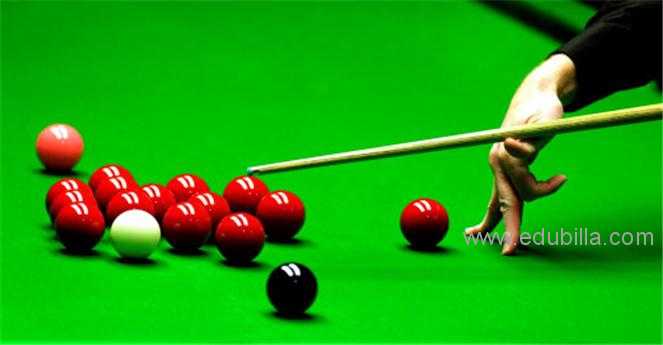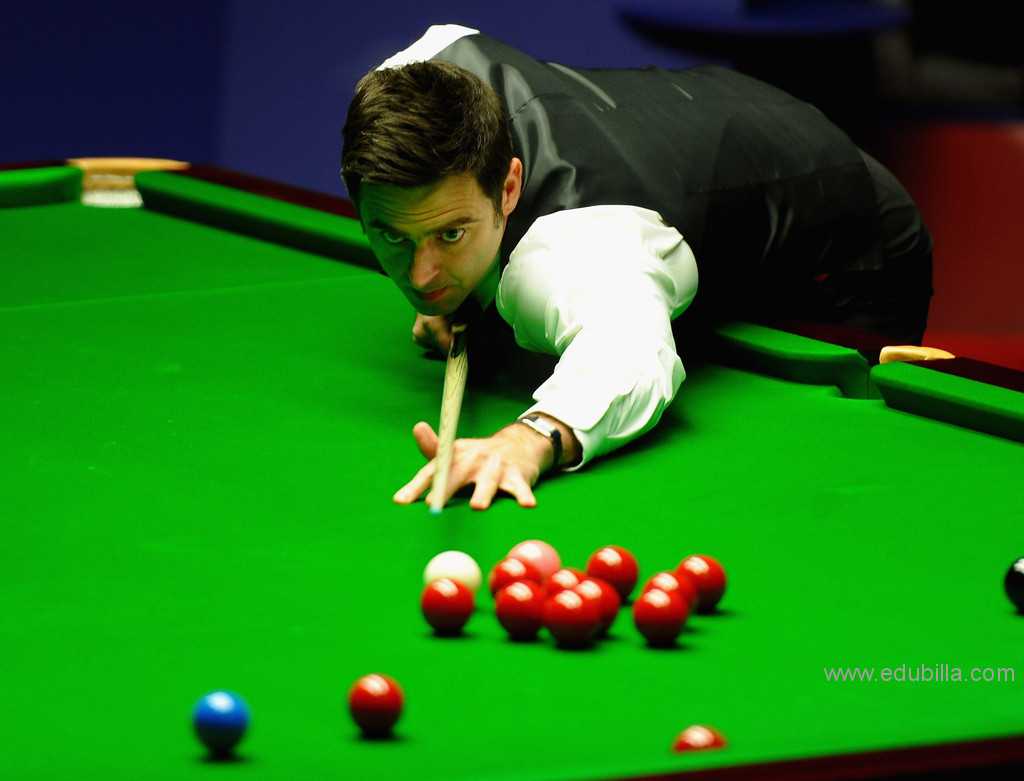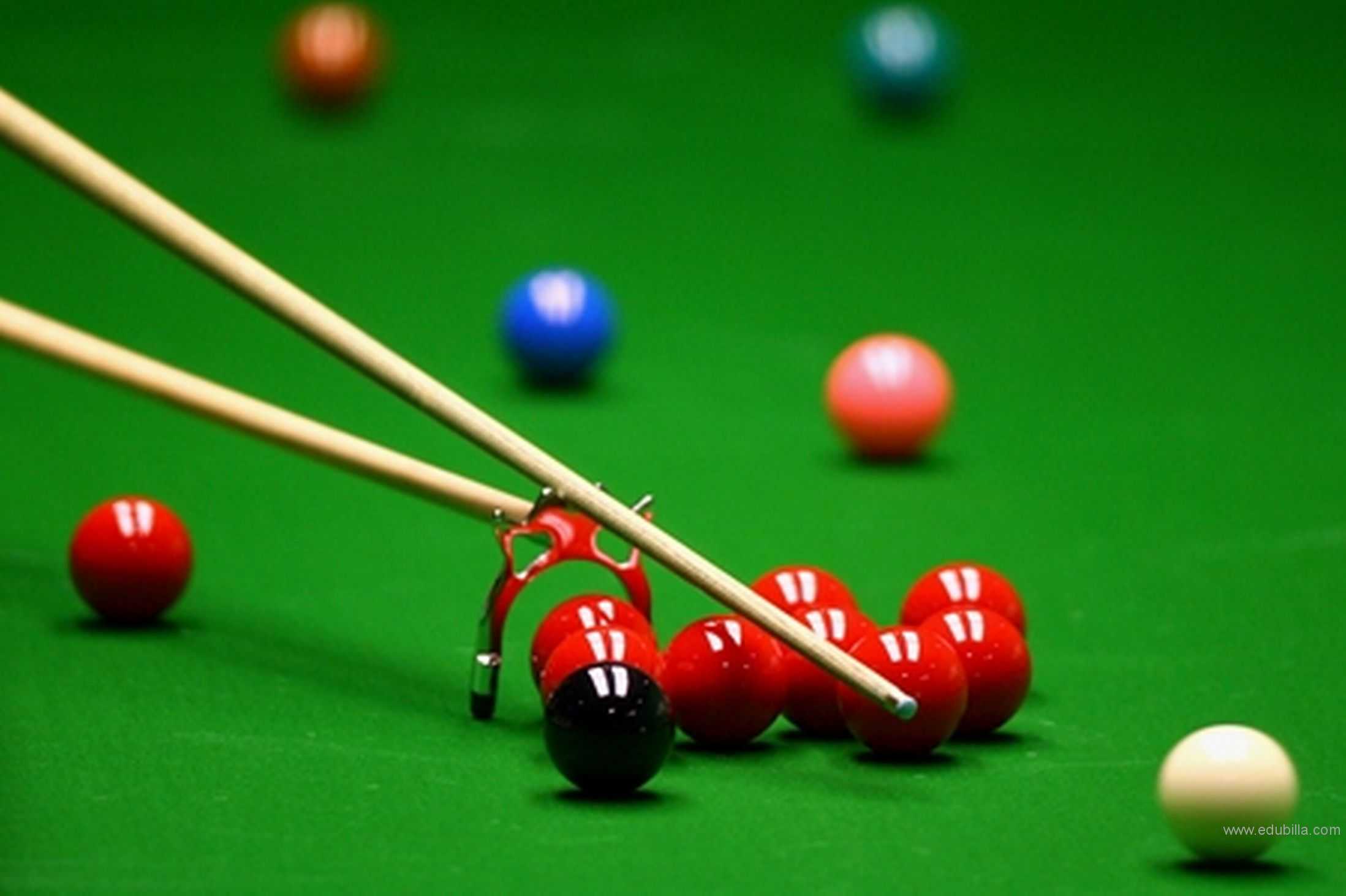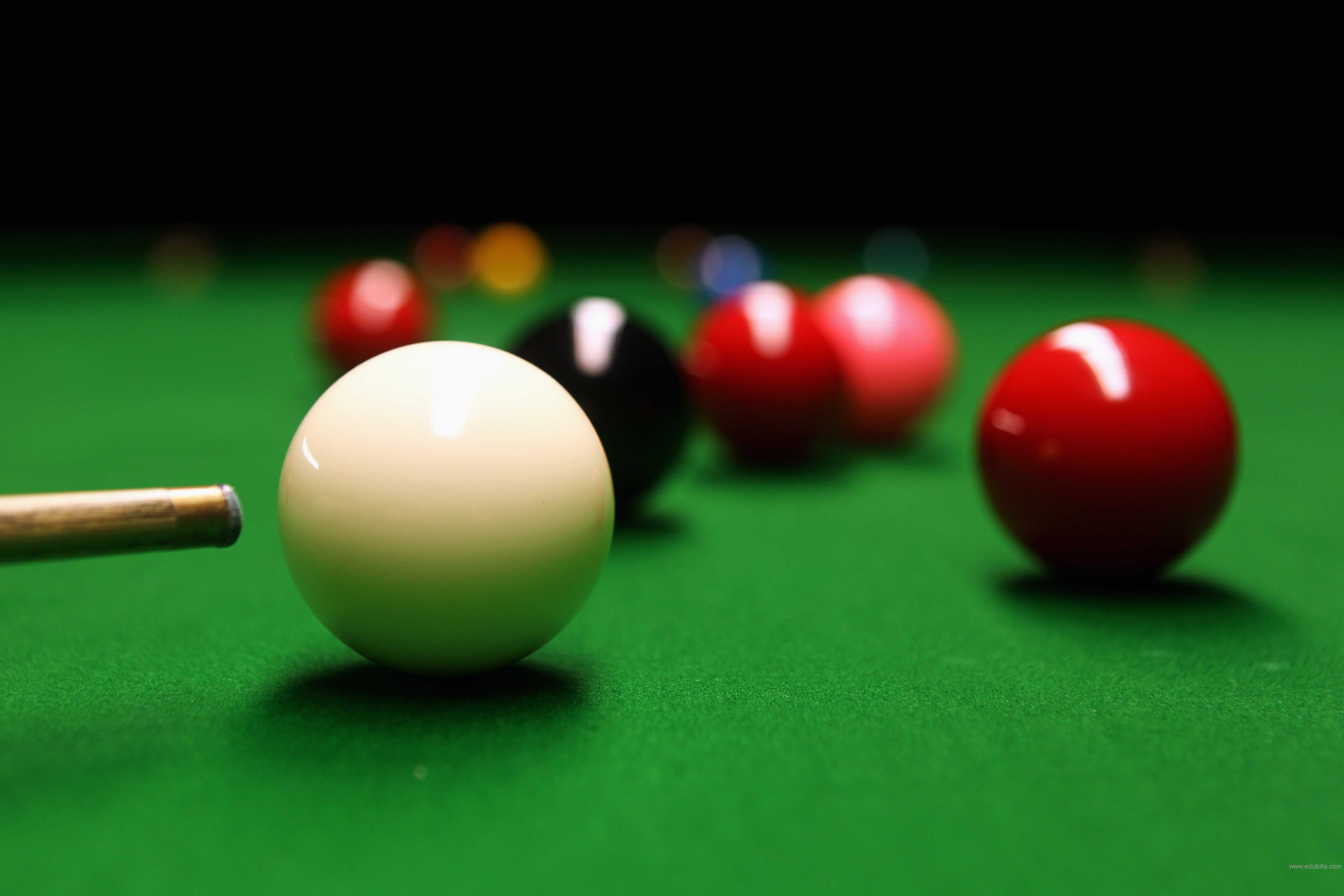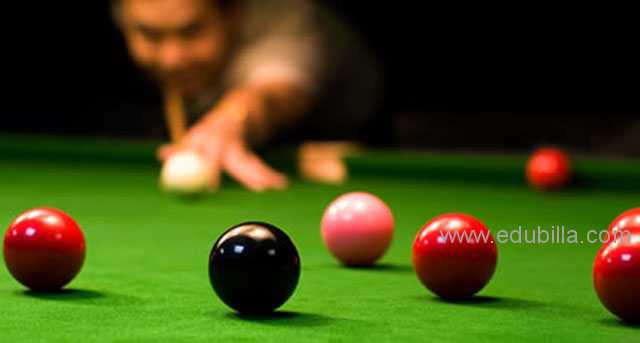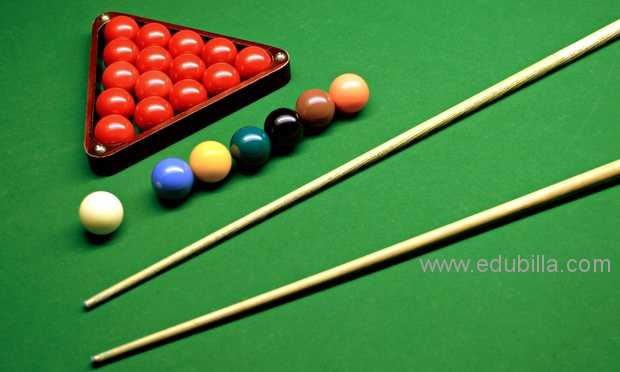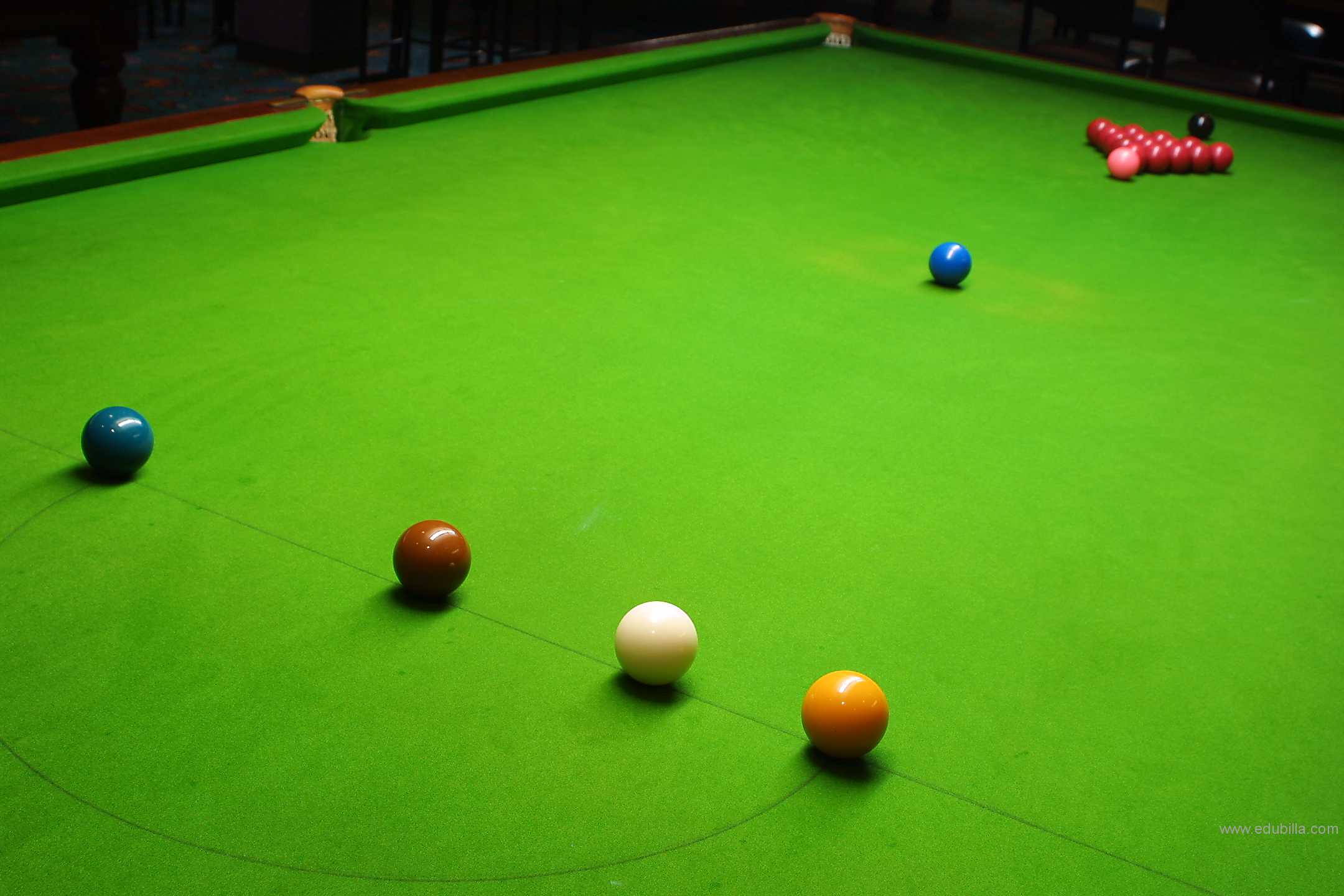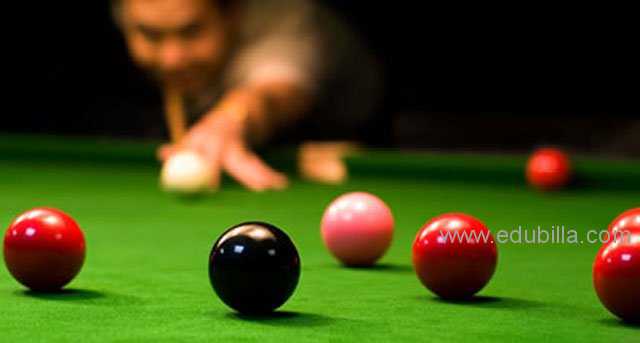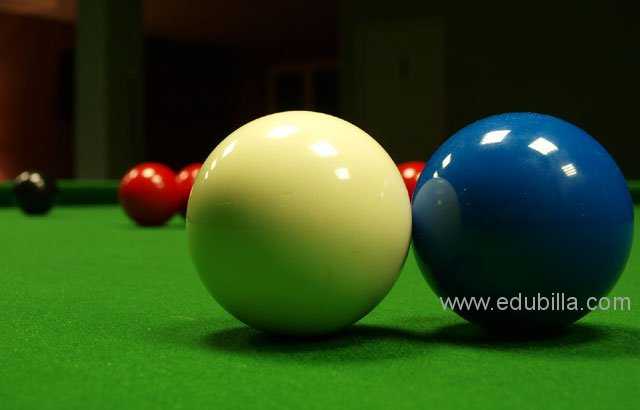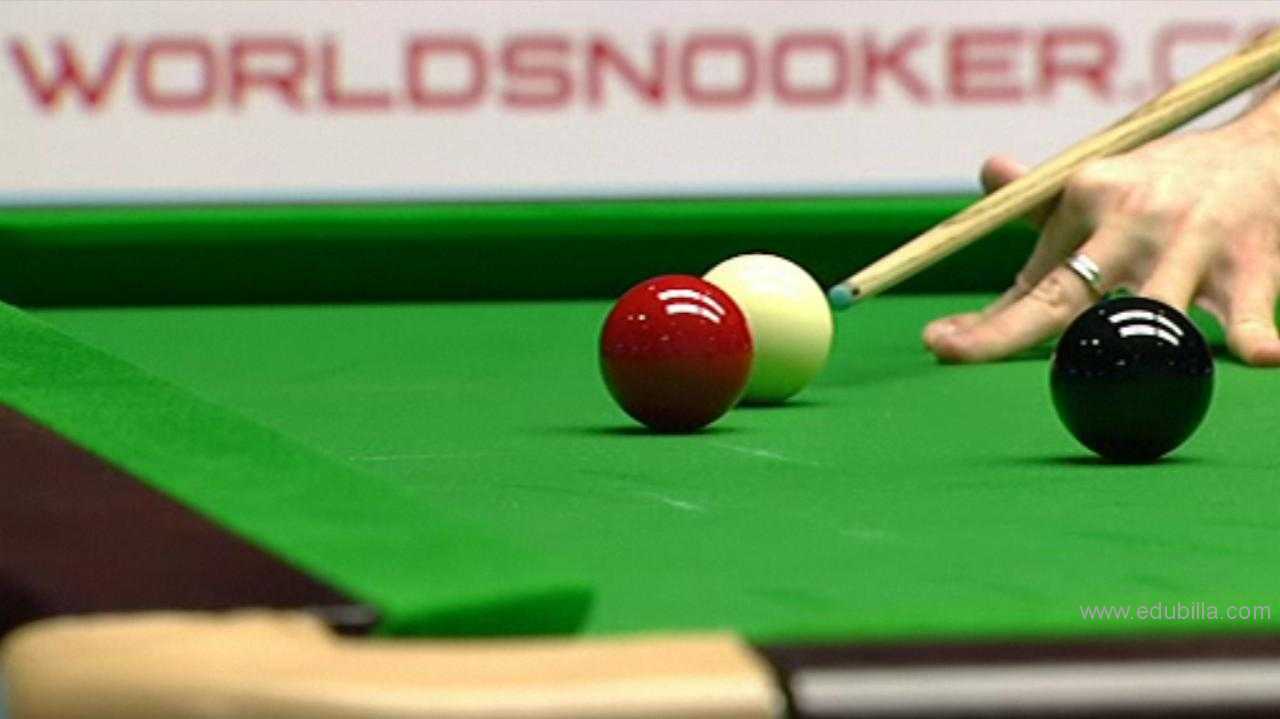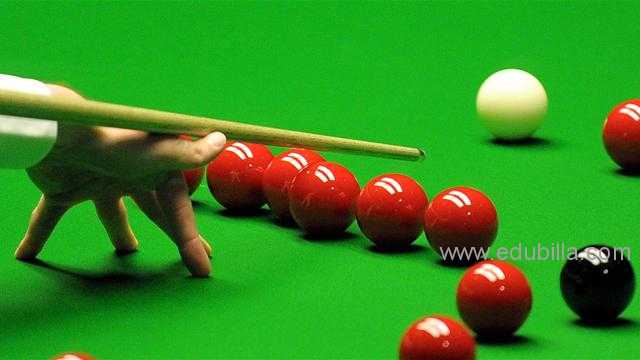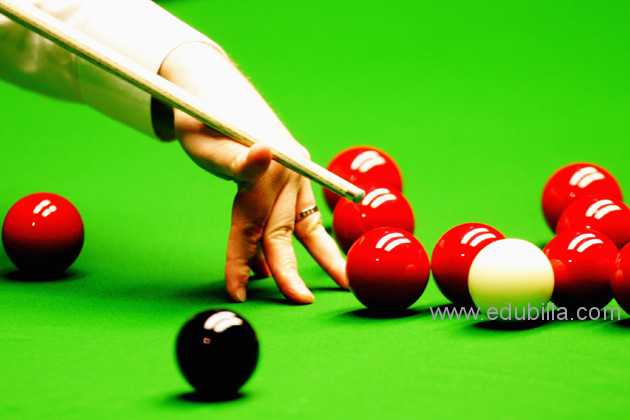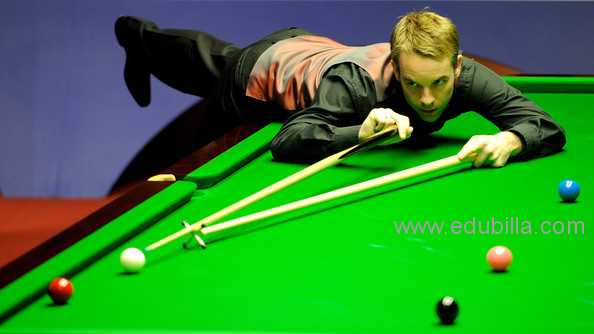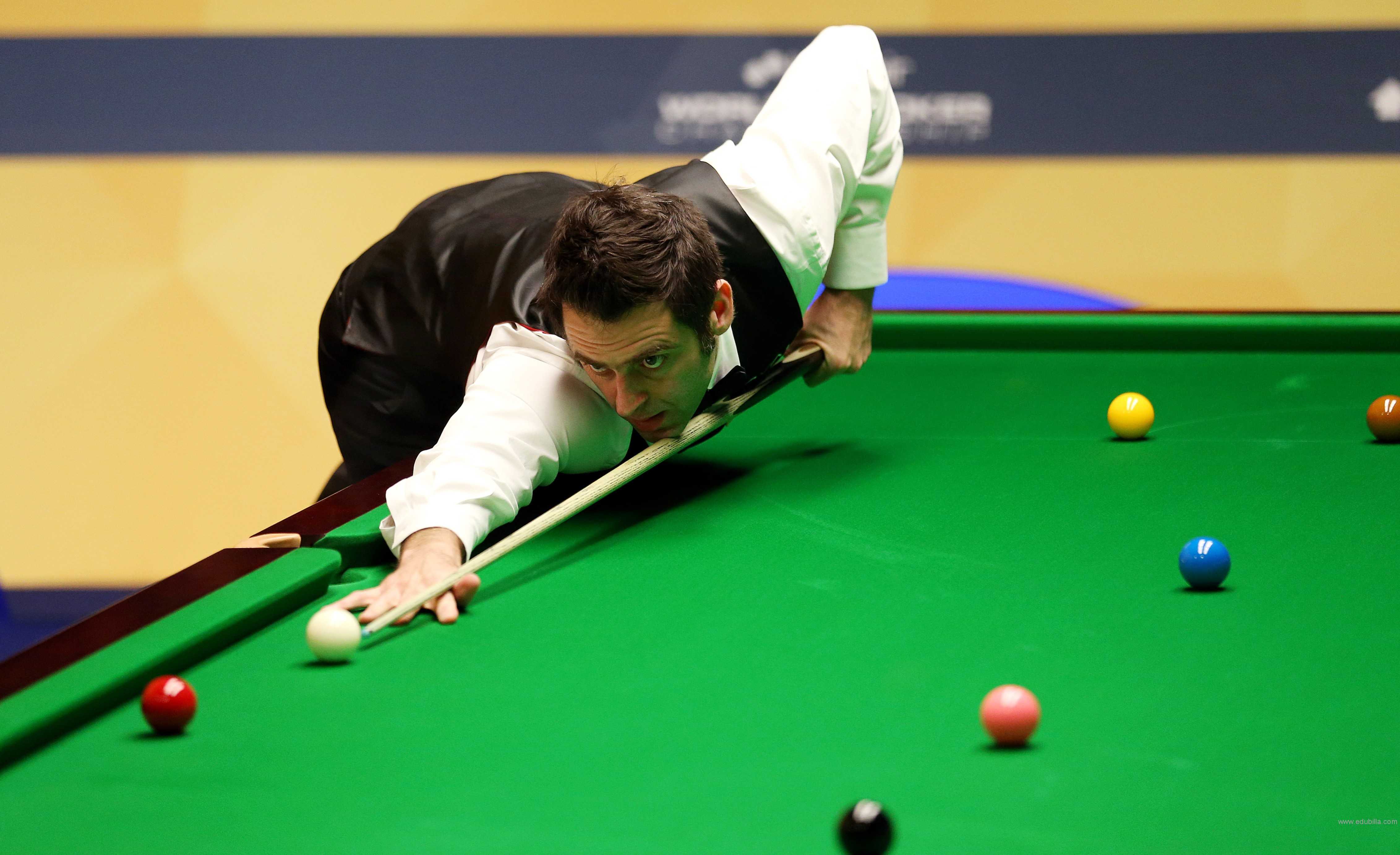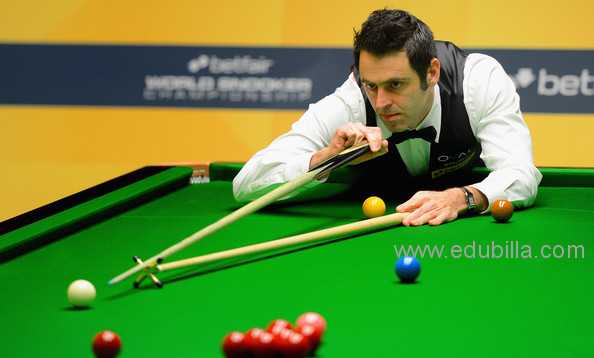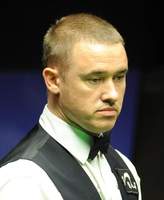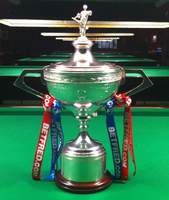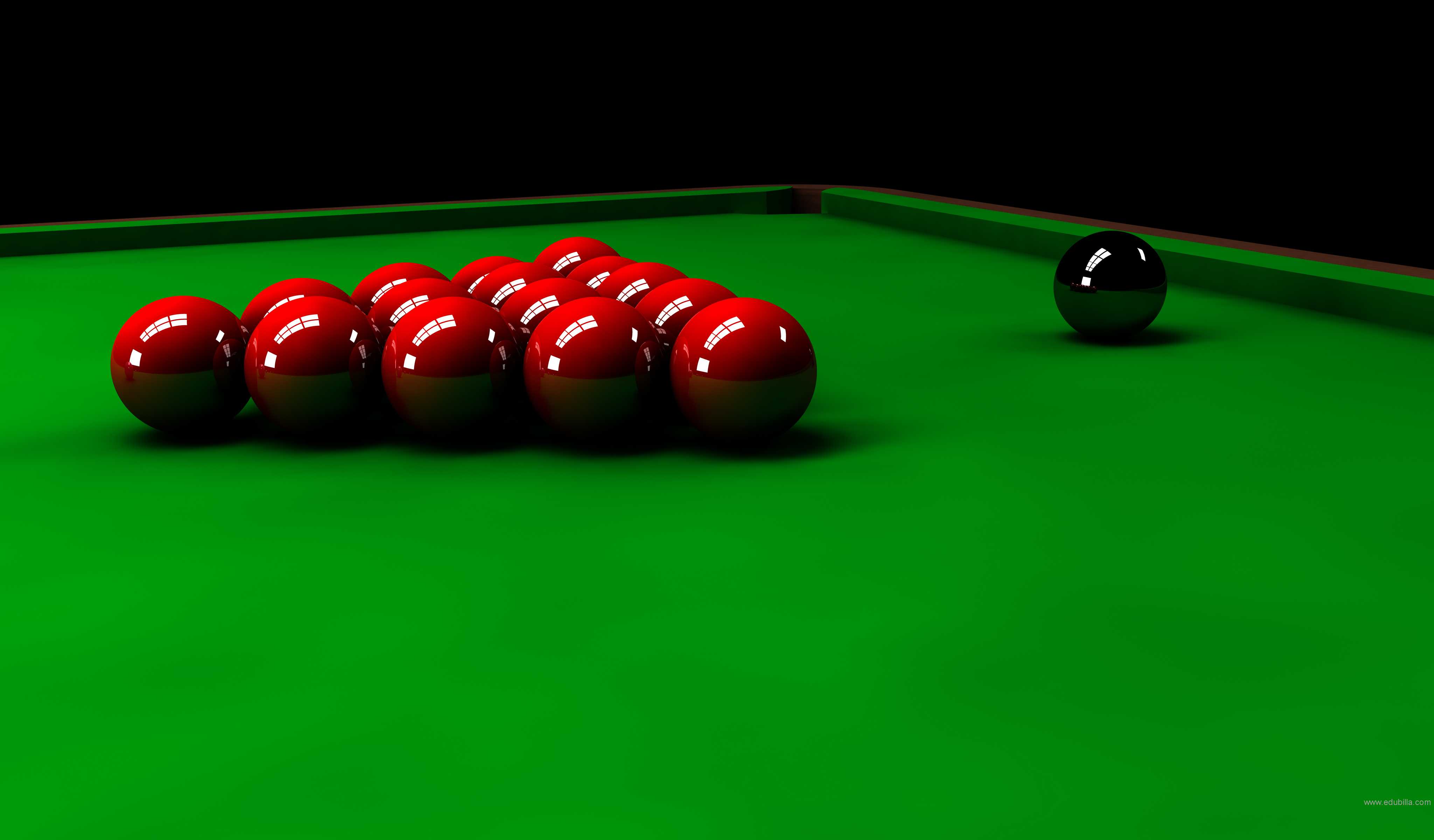
Overview Of Snooker
Snooker is a cue sport played on a table covered with a green cloth or baize, with pockets at each of the four corners and in the middle of each of the long side cushions. A full-size table measures 11 ft 81?2 in × 5 ft 10 in (3569 mm x 1778 mm), commonly referred to as 12 × 6 ft.
The game is played using a cue and 22 snooker balls: one white cue ball, 15 red balls worth one point each, and six balls of different colours: yellow (2 points), green (3), brown (4), blue (5), pink (6) and black (7). The red balls are initially placed in a triangular formation, and the other coloured balls on marked positions on the table known as "spots". Players execute shots by striking the cue ball with the cue, causing the cue ball to hit a red or coloured ball. Points are scored by sinking the red and coloured balls (knocking them into the pockets, called "potting") in the correct sequence. A player receives additional points if the opponent commits a foul. A player (or team) wins a frame (individual game) of snooker by scoring more points than the opponent(s). A player wins a match when a predetermined number of frames have been won.
Snooker, generally regarded as having been invented in India by British Army officers, is popular in many of the English-speaking and Commonwealth countries,with top professional players attaining multi-million-pound career earnings from the game.The sport is now increasingly popular in China.Touring professional players compete regularly around the world, the premier tournament being the World Championship, held annually in Sheffield, England.
Game Rules
Type of Game: International or "English" snooker is the most widely played form of snooker around the world. It is generally played on 6'x12' English billiard tables, with cushions that are more narrow than on pocket billiard tables and which curve smoothly into the pocket openings. 5 x 10 and snooker tables of even smaller playing dimensions may be used for the game. On a 6 x 12 snooker (English billiard) table the playing area within the cushion faces shall measure 11' 8.5" x 5' 10" with a tolerance on both dimensions of +/-0.5". The height of the table is measured from the floor to the top of the cushion rail, and the height shall measure 34" with an allowable variance of +/-0.5".
Players: 2
Balls Used: Set of Snooker balls: fifteen object balls that are not numbered and are solid red (called reds), six object balls of other colors that are not numbered (called colors) and a cue ball (called the white ball). Point values for object balls: red-1, yellow-2, green-3, brown-4, blue-5, pink-6, black-7. In International Snooker the balls used are 2-1/16" diameter.
The Rack: Play begins with the balls placed as in the diagram above. The pink is spotted on the Pyramid Spot. The apex ball of the triangle of reds is racked as close as possible to the pink without touching it.
Baulk-line and Baulk: A straight line drawn 29" from the face of the bottom cushion and parallel to it is called the Baulk-line and the intervening space termed the Baulk.
The Half Circle: The Half Circle is a semi-circle described in Baulk with its center at the middle of the Baulk-line and with a radius of 11.5". When the striker has cue ball in hand within the Half Circle he may place the base of the cue ball anywhere on the line or within the Half Circle, and may use his hand or any part of his cue (including the tip) to position the cue ball--as long as it is judged he is not attempting to play a stroke.
Object of the Game: To score a greater number of points than opponent.
Scoring: Points are scored in two ways: players are awarded points for fouls by the opponent (see Penalties For Fouls below), and by legally potting reds or colors. Each legally potted red ball has a point value of one; each legally potted color ball has a point value as indicated (Balls Used above). A frame ends when all balls have been potted, following the Rules of Play; if, however, only the black (7) ball is left on the table, the frame ends with the first score or foul. If the players' scores are equal after that scoring, the black is spotted on its original position and the layers lag or draw lots for the choice of playing at, or assigning opponent to play at, the black ball with the cue ball in hand within the Half Circle, first score or foul then ends the frame.
Opening Break: Players lag or draw lots for choice of break in the opening frame. In a match format the players alternate the break in subsequent frames. Starting player has cue ball in hand within the Half Circle. He must cause the cue ball to contact a red ball. It is not necessary to send a ball to a rail or into a pocket. Failure to meet this requirement is a foul (see Penalties For Fouls) A foul is scored and--with all fouls--the incoming player has a choice of (1) accepting the table and becoming the striker, or (2) requiring the offender to break again.
Rules of Play:
1. A legally potted ball entitles the striker to continue at the table until he fails to legally pot a ball.
2. On all shots, the striker must comply with the appropriate requirements of Rules of Play 5 and 6. It is not necessary to cause the cue ball or an object ball to contact a cushion or drop in a pocket after the cue ball has contacted a legal object ball (ball on). Failure to contact a legal object ball first is a foul.
3. As long as reds are on the table, the incoming striker (player taking his first stroke of an inning) always has a red as his legal object ball (ball on).
4. Any red balls potted on a legal shot are legally potted balls; the striker need not call any particular red ball(s), pocket(s) or details of how the pot will be played.
5. When the striker has a red ball as his "ball on" (legal object ball), he must cause the cue ball's first contact to be with a red ball. Failure to do so is a foul (See Penalties For Fouls)
6. After the striker has scored a red ball initially, his next legal object is a color, and as long as reds remain on the table he must alternate his play between reds and colors (though within each group he may play a ball of his choice). When reds remain on the table and a color is his object, the striker must (a) designate prior to stroking which color ball is his object (that specific color is then his "ball on"), and (b) cause the cue ball's first contact with a ball to be with that colored ball. If the striker fails to meet these requirements, it is a foul (See Penalties For Fouls).
7. If the striker's ball on is a red, and he pots a color, it is a foul.
8. If the striker's ball on is a color, and he pots any other ball, it is a foul.
9. Jump shots are illegal in International Snooker. It is a foul if the striker intentionally causes the cue ball to jump (rise from the bed of the table) by any means, if the jump is an effort to clear an obstructing ball.
10. While reds remain on the table, each potted color is spotted prior to the next stroke (see Spotting Balls below for spotting rules). After a color has been spotted, if the striker plays while that ball is incorrectly spotted (and opponent or referee calls it before two such plays have been taken), the shot taken is a foul. If the striker plays two strokes after such error without its being announced by opponent or referee, he is free of penalty and continues playing and scoring normally as though the spotting error simply had not occurred. The striker is responsible for ensuring that all balls are correctly spotted before striking. If the striker plays while a ball(s) that should be on the table is not a foul may be awarded whenever the foul is discovered during the striker's inning. Any scoring prior to the discovery of the foul will count.
11. When no reds remain on the table, striker's balls on become the colors, in ascending numerical order (2,3,4,5,6,7). These legally potted colors are not spotted after each is potted; they remain off the table. (The black (7) ball is an exception in the case of a tie score; see Scoring.)
Illegally Potted Ball: Reds illegally potted are not spotted; they remain off the table. Colors illegally potted are spotted. (See Spotting Balls.)
Object Balls Jumped off the Table: Reds jumped off the table are not spotted and the striker has committed a foul. Colors jumped off the table are spotted and the striker has committed a foul. (See Penalties For Fouls)
Spotting Balls: Reds are never spotted. Colors to be spotted are placed as at the start of the game. If a color's spot is occupied (to mean that to spot it would make it touch a ball), it is placed on the spot of the highest value color that is unoccupied. If all spots are occupied, the color is spotted as close as possible to its original spot on a straight line between its spot and the nearest point on the top (foot) cushion.
Cue Ball after Jumping off the Table: Incoming player has cue ball in hand within the Half Circle. When cue ball is in hand within the Half Circle (except the opening break), there is no restriction (based on position of reds or colors) as to what balls may be played; striker may play at any ball on regardless of where it is on the table.
Touching a Ball: While balls are in play it is a foul if the striker touches any object ball or if the striker touches the cue ball with anything other than the tip during a legal stroke.
Snookered: The cue ball is snookered when a direct stroke in a straight line to any part of every ball on is obstructed by a ball or balls not on. If there is any one ball that is not so obstructed, the cue ball is not snookered. If in-hand within the Half Circle, the cue ball is snookered only if obstructed from all positions on or within the Half Circle. If the cue ball is obstructed by more than one ball, the one nearest to the cue ball is the effective snookering ball.
Angled: The cue ball is angled when a direct stroke in a straight line to any part of every ball on is obstructed by a corner of the cushion. If there is any one ball on that is not so obstructed, the cue ball is not angled. If angled after a foul the referee or player will state "Angled Ball", and the striker has the choice to either (1) play from that position or (2) play from in hand within the Half Circle.
Occupied: A spot is said to be occupied if a ball cannot be placed on it without its touching another ball.
Touching Ball: If the cue ball is touching another ball which is, or can be, on, the referee or player shall state "Touching Ball." Thereafter the striker must play away from it or it is a push stroke (foul). No penalty is incurred for thus playing away if (1) the ball is not on; the ball is on and the striker nominates such ball; or (3) the ball is on and the striker nominates, and first hits, another ball.
Push Stroke: A push stroke is a foul and is made when the tip of the cue remains in contact with the cue ball (1) when the cue ball makes contact with the object ball, or (2) after the cue ball has commenced its forward motion. Provided that where the cue ball and an object ball are almost touching, it shall be deemed a legal stroke if the cue ball hits the finest possible edge of the object ball.
Miss: The striker shall to the best of his ability endeavor to hit the ball on. If the referee considers the rule infringed he shall call foul and a "miss." The incoming player (1) may play the ball(s) as they lie, or (2) may request that the ball(s) be returned to the original position and have the offending player play the stroke again. Note: if the ball on cannot possibly be hit, the striker is judged to be attempting to hit the ball on.
Free Ball: After a foul, if the cue ball is snookered, the referee or player shall state "Free Ball." If the non-offending layer takes the next stroke he may nominate any ball as on. For this stroke, such ball shall be regarded as, and acquire the value of, the ball on. It is a foul should the cue ball fail to first hit, or - except when only the pink and black remain on the table - be snookered by, the free ball. If the "free ball" is potted, is is spotted, and the value of the ball on is scored. if the ball on is potted it is scored. If both the "free ball" and the ball on are potted, only the value of the ball on is scored.
Fouls
If a foul is committed:
1. the player who committed the foul incurs the penalty prescribed (which is added to the opponent's score), and has to play again if requested by the next player. Once such a request has been made it cannot be withdrawn. 2. should more than one foul be committed in the same stroke the highest value penalty shall be incurred. 3. any ball improperly spotted shall remain where positioned, except that if off the table it shall be correctly spotted.
Penalties for Fouls
The following are fouls and incur a penalty of four points or the higher one prescribed:
1. value of the ball on -
by striking:
a) when the balls are still moving from the previous shot. b) the cue ball more than once (double hit). c) without at least one foot on the floor. d) out of turn. e) improperly from in hand within the Half Circle.
by causing:
f) the cue ball to miss all object balls. g) the cue ball to enter a pocket. h) a snooker with free ball. i) a jump shot.
2. value of the ball on or ball concerned -
by causing:
a) a ball not on to enter a pocket. b) the cue ball to first hit a ball not on. c) a push stroke. d) by striking with a ball not correctly spotted. e) by touching a ball with other than the tip of the cue. f) by forcing a ball off the table.
3. value of the ball on or higher value of the two balls by causing the cue ball to hit simultaneously two balls other than two reds or a "free ball" and the ball on.
4. penalty of seven points is incurred if -
the striker
a) after potting a red commits a foul before nominating a color.
b) uses a ball off the table for any purpose.
c) plays at reds in successive strokes.
d) uses as the cue ball any ball other than the white one.
Equipments Need For Snooker
Table
The playing surface, 11 feet 8.5 inches by 5 ft 10 inches for a standard full-size table, with six pockets, one at each corner and one at the center of each of the longer side cushions. For further information see Billiard table, specifically the section Snooker and English billiards tables.
Cloth:
The cloth is usually green with a directional nap running from the baulk end of the table towards the end with the black ball spot (often called baize, however baize is a much inferior type of cloth sometimes used on pool tables). The nap will affect the direction of the cue ball depending on which direction the cue ball is shot and also on whether left or right side (spin) is placed on the ball. Even if the cue ball is hit in exactly the same way, the nap will cause a different effect depending on whether the ball is hit down table (towards the black ball spot) or up table towards the baulk line. The cloth on a snooker table should not be vacuumed especially if the vacuum head has beater brushes as this can destroy the nap. The best method is to brush the cloth in a straight line from the baulk end to the far end. Multiple brush strokes are fine as long as they are straight in direction (i.e. not across the table). Some table men will also then drag a dampened cloth wrapped around a short piece of board (like a two by four) to collect any remaining fine dust and help lay the nap down. Strachan cloth as used in official snooker tournaments is made up of 100% wool. Some other cloths include a small percentage of nylon.
Balls:
22 balls (15 red, six colour balls and a white cue ball), 52.5 mm or 21?16 inches in diameter. For further information see Billiard ball, particularly the section Snooker
Cue:
A stick, made of wood or fibreglass, tapering to a tip, usually ending in leather, which is used to strike the cue-ball.
Cue-tip chalk:
The tip of the cue is "chalked" to ensure good contact between the cue and the cue-ball. This "chalk" is generally a silica based compound rather than actual chalk of the type used used on blackboards.
Extension:
A shorter baton that fits over, or screws into, the back end of the cue, effectively lengthening it. Is used for shots where the cue ball is a long distance from the player.
Rest:
A stick with an X-shaped head that is used to support the cue when the cue ball is out of reach at normal extension.
Rest head adaptor:
An attachment that slips onto a conventional rest head to make a spider or just to give a slightly different bridge.
Hook rest
Identical to the normal rest, yet with a hooked metal end. It is used to set the rest around another ball. The hook rest is the most recent invention in snooker.
Spider:
Similar to the rest but with an arch-shaped head; it is used to elevate and support the tip of the cue above the height of the cue-ball.
Swan (or swan-neck spider or giraffe):
This equipment, consisting of a rest with a single extended neck and a fork-like prong at the end, is used to give extra cueing distance over a group of balls. If not available, a regular X rest can be placed on a spider so it in turn hangs the required distance beyond to provide similar support.
Triangle/Rack:
The piece of equipment is used for gathering the red balls into the formation required for the break to start a frame.
Extended rest:
Similar to the regular rest, but with a mechanism at the butt end which makes it possible to extend the rest by up to three feet.
Extended spider:
A hybrid of the swan and the spider. Its purpose is to bridge over large packs of reds. Is less common these days in professional snooker but can be used in situations where the position of one or more balls prevents the spider being placed where the striker desires.
Half butt:
Usually housed underneath the side of the table, the half butt is a combination of a table length rest and cue which is rarely used unless the cue ball needs to be struck in such a way that the entire length of the table is the actual obstacle.
Ball marker:
A multi-purpose instrument with a "D" shaped notch, which a referee can (1) place next to a ball, in order to mark the position of it. They can then remove the ball to clean it; (2) use to judge if a ball is preventing a colour from being placed on its spot; (3) use to judge if the cue ball can hit the extreme edge of a "ball on" when awarding a free ball (by placing it alongside the potentially intervening ball).
History Of Snooker
In the early days of snooker, it was generally accepted that the game of snooker originated in the British Army garrisons of India as a combination of the various billiard games, particularly English billiards, which where then commonly played. Beyond this nobody laid claim to its specific origins until a debate began in the late 1930s.
The beginning:
In the 19th century, the sport became quite popular among the British Armed Forces stationed in India. Billiards was a two-man game in its original form, which was played with 3 balls, of which two were cue balls, one for each player. This led to the formation of multi-player versions. New versions included life pool and pyramid pool. Life pool involved several colored balls used as both cue balls and object balls. In pyramid pool, there were 15 red balls and a white cue ball, and each player received one point per red ball potted. Along with the new games being developed, the table was taking steps toward its current state.
Etymology:
The name snooker comes from a comment Chamberlain made about a player who missed a shot. He called him "a real snooker", referring to his lack of experience, "snooker" being a slang term for a first year cadet.
First Set of Rules:
The first official set of rules for snooker were drafted in 1882 at Ootacamund in Madras Province. When British Billiards Champion John Roberts travelled to India in 1885, he met Chamberlain and decided to introduce snooker to England when he returned home.
First Official Competitions:
The first official competitions, the English Amateur Championships, took place in 1916. In 1927, Joe Davis helped to establish the first Professional World Championship of snooker. Joe Davis won and took home the prize of £6.10. At that time, the standard of play was not very high considering that the highest break of that tournament was just 60. By the 1930s, Snooker was becoming one of the most popular cue sports.
The Joe Davis Era:
Joe Davis continued to dominate the era, winning every World Championship until his retirement in 1946. Having said this, the ruling back then that the defending champion received a bye into the final so the other players were battling it out for a shoot-out with the defending champion.
Between 1952 and 1957, a dispute arose between the games' governing bodies, The Control Council and the Billiards Association. As a result, only two people participated in the official World Championship, although an unofficial one was organized. At the time, the winner of the unofficial tournament was generally considered the best player in the world. During this time frame Horace Lindrum won the official World Championship. Due to a decline in popularity, there were no world championships between 1958 and 1963.
In order to try and revitalise the popularity of snooker Joe Davis invented Snooker Plus.
Origin Of Snooker
The game of snooker is a cue sport which emerged in its modern form in the late 19th century, with roots going back to the 16th century form of English billiards. Billiards was popular among the British Armed Forces stationed in India. As billiards was only a two player game, new games such as life pool and pyramid pool were developed in order to accommodate more players. Eventually, these two games were combined to form snooker.
First Played:
Billiards was first played in the 16th century. It was known as a "gentleman's game" because of its popularity among royalty. The tables had no side rails, pockets, or cushions, but only contained holes for the balls to be potted. Every time that a pot was achieved, the ball would fall to the ground. The balls, which were made of ivory, were another difference from modern billiards.
The early years:
The first official competitions, the English Amateur Championships, took place in 1916. In 1927, Joe Davis helped to establish the first Professional World Championship of snooker. Joe Davis won and took home the prize of £6.10. At that time, the standard of play was not very high considering that the highest break of that tournament was just 60. By the 1930s, Snooker was becoming one of the most popular cue sports.
Joe Davis continued to dominate the era, winning every World Championship until his retirement in 1946. Between 1952 and 1957, a dispute had arisen among the games' governing body, the Control Council, and the Billiards Association. As a result, only two people participated in the official World Championship, although an unofficial one was organized. At the time, the winner of the unofficial tournament was generally considered the best player in the world. During this time frame Horace Lindrum won the official World Championship. Due to a decline in popularity, there were no world championships between 1958 and 1963.
Governing Bodies
World Professional Billiards and Snooker Association:
The World Professional Billiards and Snooker Association (WPBSA), founded in 1968 and based in Bristol, the United Kingdom, is the governing body of men's professional snooker and English billiards. It sets the rules of the sport, organises tournaments, the pro-am, and pro tours, and engages in promotional activities on behalf of the sport.
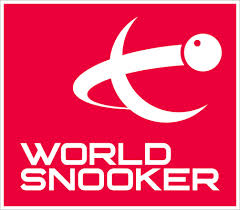
History:
The organisation was founded in 1968.Prior to the formation of the WPBSA, the world governing body of both snooker and English billiards was the Billiards Association and Control Council (BACC).
The objectives of the WPBSA include:
- To promote, encourage and popularise the games of snooker and billiards generally and in particular for the benefit of Members of the Company,
- To preserve the prestige and dignity of professional snooker and billiards,
- To provide through Rules and Regulations for deciding and settling all differences that may arise between Members of the Company in reference to due compliance with the Laws of the games of snooker and billiards or the Rules and Regulations of the Company.
To Visit WPBSA Click Here.
Awards Related To Snooker
WPBSA Awards:
- World Snooker Player of the Year
- Snooker Journalists Player of the Year
- Fans Player of the Year
- Rookie of the Year
- Performance of the Year
- Magic Moment of the Year
- 147 Club (players making a 147 during the season)
Selby sweeps snooker awards:
World Snooker Player of the Year
Snooker Writers Player of the Year
Fans Player of the Year
Rookie of the Year
Performance of the Year
Magic Moment of the Year
147 Club (players making a 147 during the season)
Hall of Fame inductees
Canadian Snooker Awards
The Bob Hargrove Award:
The Bob Hargrove award is awarded to a referee who has contributed to our sport here in Canada with dedication, class and distinction.
Sample Documents Of Snooker
-Viswanathan Anan

